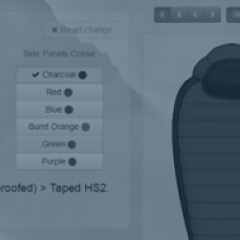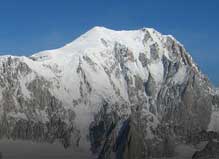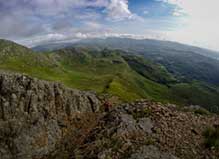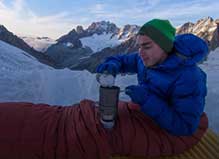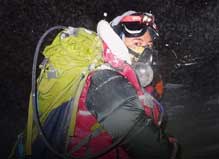"Your double suit is the most versatile out there. When Ben Fogel wore his when we both summited Everest he was able to regulate his heat way better than I could in a more traditional suit."
—Sixteen times Everest summiteer and expedition guide, Kenton Cool
"For a suit that is literally made to measure and is totally fit for purpose then look no further. You get exceptional value for money and it's more versatile than the other suits available. 9.25/10."
[Tim rated the PHD Double Expedition Suit 1st in his review of down suits by PHD, Rab, Mountain Hardwear, North Face, Berghaus, Marmot, and Mountain Equipment.]
—Six times Everest summiteer and expedition guide, Tim Mosedale (read full review)
"For a suit that is literally made to measure and is totally fit for purpose then look no further. You get exceptional value for money and it's more versatile than the other suits available. 9.25/10."
[Tim rated the PHD Double Expedition Suit 1st in his review of down suits by PHD, Rab, Mountain Hardwear, North Face, Berghaus, Marmot, and Mountain Equipment.]
—Six times Everest summiteer and expedition guide, Tim Mosedale (read full review)
"The Double Suit is mega. It's a really great system. I can't climb when I get hot and the Double Suit is just perfect for avoiding over-heating. I hate faff and the idea of having to unzip a traditional down suit and have it hanging around your waist is the kind of thing that makes my blood boil. I watched climbers leaving Camp 2, often in the afternoon in the heat of the Himalayan sun, on their way to Camp 3 in full down suits and it looked terrible. I wouldn't have been able to take ten steps without steaming up and going back to camp!"
—Jon Griffith using the PHD Expedition Double Suit on Everest
"On the summit, I was ample warm with just the inner suit and came down MUCH MORE comfortable than anyone else. Overheating was a major factor for my teammates - so much so that one almost didn't get down due to a combination of fatigue and heat-exhaustion. I was chipper on the other hand.
The beauty of the inner suit system was its softness and flexibility which allowed me to move a lot more freely than in a more conventional, bulkier suit."
— Rob Casserley using the PHD Expedition Double Suit on Cho Oyu (8,188m)
"I came to love the suit. Most of the time prior to summit day I did not need the outer top, being warm enough with just the inner and the overtrousers. On summit day I wore the jacket as well. I think the design that allows the harness to be worn on the inner, with the yellow gear loops on the outer jacket, is terrific. By the end of the trip, I was positively flaunting the suit, I was so pleased with it. Great suit. I look forward to my next chance to use it."
—James Strohfeldt using the Double Down Suit on Everest North Ridge
"Although, with wind-chill, the temperature was about minus 40°C, I didn’t feel cold at any time during my 17 hour summit push. Even in the notorious queue back down the Hillary Step, I did not once feel cold. I give credit to my PHD Double Down suit for this. On the descent to Camp 4 it was a Godsend to be able to remove the down jacket and be way more comfortable than the majority of other climbers on the mountain. In fact, the one-piece base down layer was so effective that I only had to wear the outer down layer on summit day. Thanks again for making great mountain gear."
—
Roland Thomas using the PHD Expedition Double Suit on Everest
"I absolutely loved your double suit on Everest and I would recommend it to all my climbing friends especially as it can be made to fit smaller people."
— Rowena Lewthwaite using the PHD Expedition Double Suit on Everest
"I absolutely love the double suit combo. I wore the under down suit a lot at Advanced Base Camp. I found it kept me warm and was really handy. I would then add the jacket and trousers higher up for more warmth. But, I could also just wear the outer jacket. The down suit is super light and soft and not heavy which is great for carrying less weight. I liked the design and the pockets and the colour. I was never at any point cold."
— Kirsty Watson using the Double Down Suit on Everest
"What I find most impressive is adaptability of the system. The inner suit is a 'live in' piece of gear, ideally for use above 6500m, up to over 7500m, possibly higher. Once I put it on, I didn't need to take it off until the descent to Base Camp. What I really like is this allows you to wear the suit over base and mid-layers and leave shell layers at lower camps. On average this will save around 1kg of weight.
Traditional down suits have been worn only from the higher camps up to the summit. In warm conditions the climber is either uncomfortable or takes the suit off and carries it in on their back. This system allows you to utilise the insulation you are carrying lower down, climb through greater temperature ranges and generally be more comfortable and adaptable to changing weather.
Overall, the materials used are on the cutting edge of design for high altitude gear, the build quaility is exceptional and the design concept of a double suit is functional and practical."
— Ben Kane using the PHD Expedition Double Suit on Manaslu (8,163m)
"I found a single base layer and the inner suit is about all I needed in temperatures above -10 Fahrenheit (-23C), as long as I was moving, and the wind was less than 15 knots. In colder temperatures I put the outer suit on. I only need to wear the inner suit on the way back to camp 3! I took off the outer trousers by the 3rd step. On the summit I had the outer jacket on, but open. Other climbers in traditional down suits were feeezing/dripping wet with sweat, especially when climbing the North Col! People were giving up from sweating too much."
—
Frank Campanaro using the Double Down Suit on Everest
"This strikes me as a leap forward in the down suit concept. I'll be wearing the suit combo to the summit of Everest as I endeavour to take over 350 photos to be able to create the first 360°x180° gigapixel sphere. The process can take up to 45 minutes ... which on the summit of the BIG hill means you need to be equipped with the best gear that money can buy. I'm honoured to be flying the flag for PHD safe in the knowledge that I am wearing a suit combination that will keep me roasty toasty as I am subjected to some of the harshest conditions on earth."
— 6 times Everest summiteer Tim Mosedale
"The PHD double suit has really many assets. In addition to the perfect fit and the build quality, for me one of the key advantages is its adaptability to different conditions. This came in very handy for me on Ama Dablam. Descending from the summit to Camp 2 in the blazing sun with a traditional single down suit would have been a nightmare!"
— Alessandro Dazio
"My summit suit was the envy of our climbing group. The flexibility of having an inner suit that you could wear alone for temperature control combined with all the little details having been thought of by PHD, from inner bottle pockets to gear loops and hand warmer pockets in the sleeves, meant that I was extremely confident in my kit going for the summit push. My sleeping bags were also PHD and were both exceptional, as were my slippers and minimus down vest which made for a brilliant layering option up the hill."
David Brock who summited Everest in the PHD Exhibition Double Suit.
"The double down suit was a life saver in this expedition, the heat during the way down from the summit was intense and to be able to take part of the suit off probably saved me from severe dehydration! Highly recommend PHD"
Steve Davis who summited Everest in the PHD Exhibition Double Suit.







